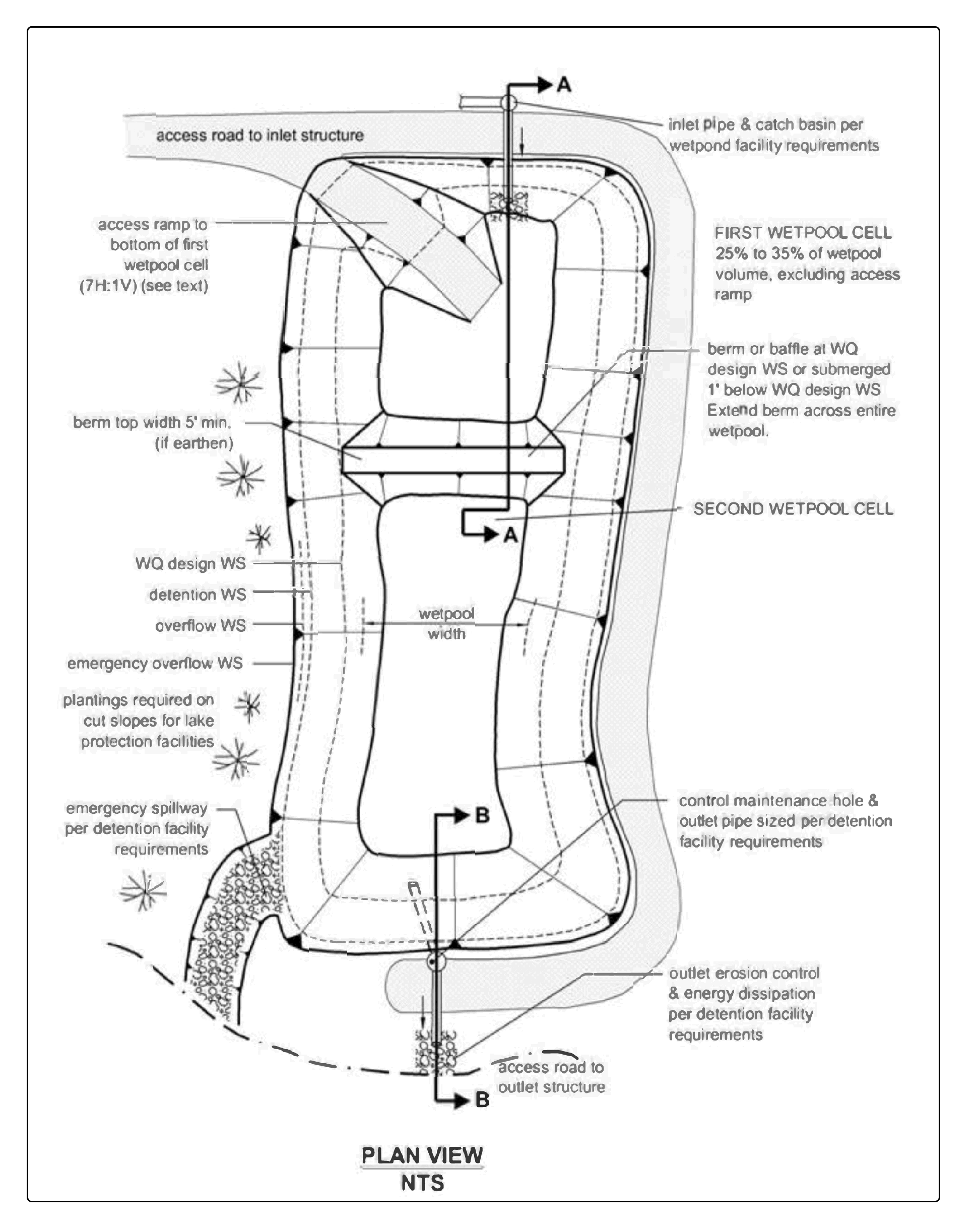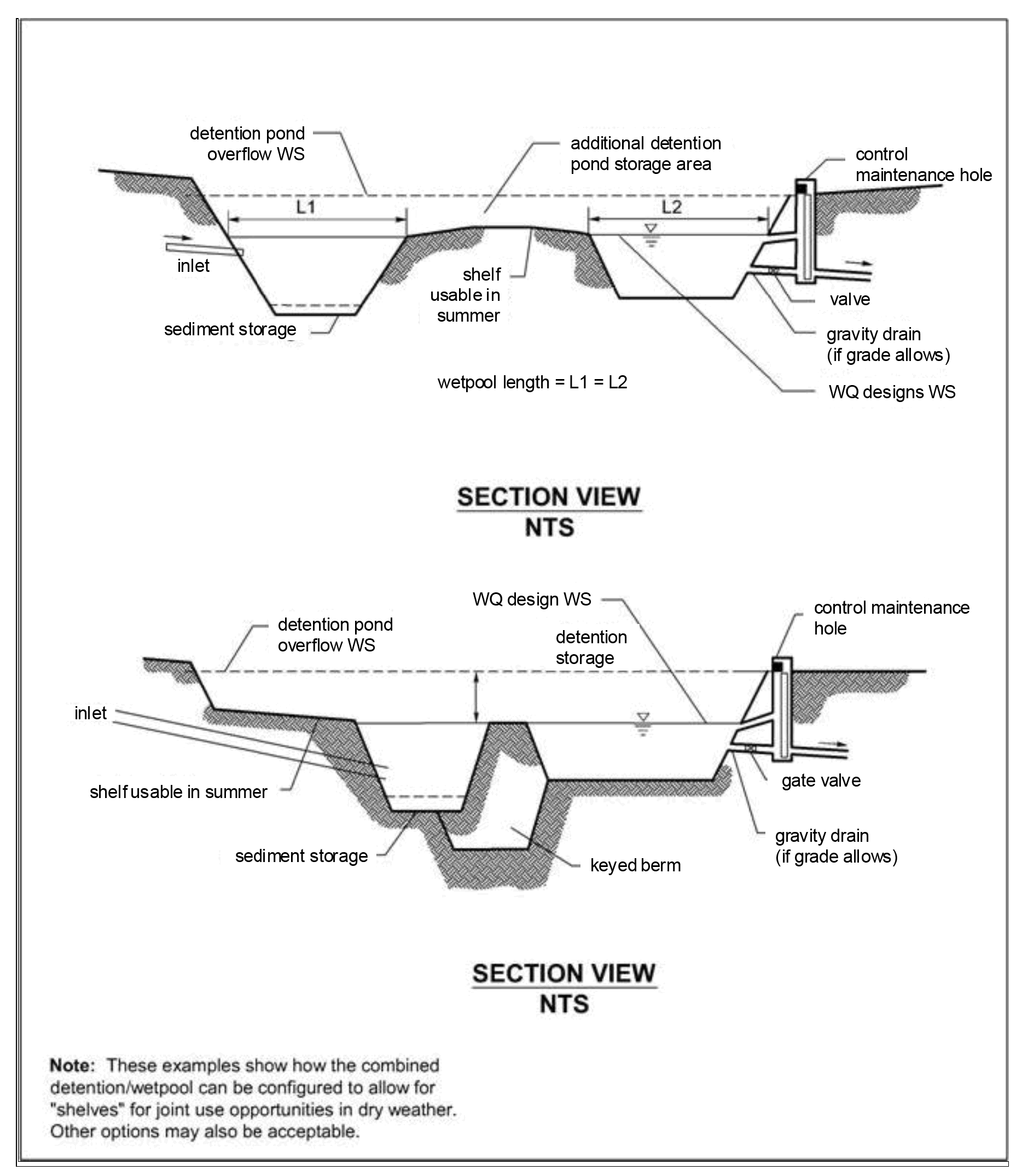15.4 BMP T1140 - Combined Detention and Wetpool Facilities
Combined detention and stormwater treatment wetpool facilities have the appearance of a detention facility but contain a permanent pool of water as well. The following design procedures, requirements, and recommendations cover differences in the design of the stand-alone stormwater treatment facility when combined with detention storage. The following combined facilities are addressed:
Detention/wetpond (basic and large)
There are two sizes of the combined wetpond, a basic and a large, but only a basic size for the combined wetvault and combined stormwater wetland. The facility sizes (basic and large) are related to the pollutant removal goals.
15.4.2 Applications and Limitations
Combined detention and wetpool facilities can be used to help ensure compliance with Minimum Requirement 5 - Onsite Stormwater Management for Meeting the LID Performance Standard Only, Minimum Requirement 6 - Stormwater Treatment, Minimum Requirement 7 - Flow Control, and Minimum Requirement 8 - Wetlands Protection.
Combined detention and stormwater treatment facilities are efficient for sites that also have detention requirements. The stormwater treatment facility may often be placed beneath the detention facility without increasing the facility surface area. However, the fluctuating water surface of the live storage will create unique challenges for plant growth and for aesthetics alike.
The live storage component of the facility shall be provided above the seasonal high water table.
15.4.3 BMP T1140a - Combined Detention and Wetponds
Typical design details and concepts for a combined detention and wetpond are shown in
Figure 4 - 41: Combined Detention and Wetpond (top view) and Figure 4 - 42: Combined Detention and Wetpond (side view). The detention portion of the facility shall meet the design criteria and sizing procedures set forth in BMP F110 - Detention Ponds.
Comply with all criteria and standards in Modeling Your Best Management Practices, Design Criteria for All Stormwater Treatment and Flow Control BMPs, Constructing Your Best Management Practices and Accessing and Maintaining Your Best Management Practices as applicable to the project in addition to criteria within each BMP. Where criteria or standards conflict, utilize the criteria and standards contained within the specific BMP.
The sizing for combined detention and wetponds are identical to those for wetponds and for detention facilities. Refer to Guidance in BMP T1110 - Wetponds - Basic and Large for sizing the wetpond portion and BMP F100 - Detention Facilities for sizing the detention portion.
Figure 4 - 41: Combined Detention and Wetpond (top view)
Figure 4 - 42: Combined Detention and Wetpond (side view)
15.4.3.1.2 Detention and Wetpool Geometry
Do not include the wetpool and sediment storage volumes in the required detention volume.
The "Wetpool Geometry" criteria for wetponds (see BMP T1010 - Basic Biofiltration Swale) shall apply with the following modifications/clarifications:
The permanent pool may be shallower to comprise most of the pond bottom, or deeper positioned to comprise a limited portion of the bottom. Note, having the first wetpool cell at the inlet allows for more efficient sediment management than if the cellis moved away from the inlet. Wetpond criteria governing water depth must still be met. See Figure 4 - 43: Alternative Configurations of Detention and Wetpool Areas for two possibilities for wetpool cell placement.
The minimum sediment storage depth in the first cell is 1-foot. The 6 inches of sediment storage required for a detention pond does not need to be added to this, but 6 inches of sediment storage must be added to the second cell to comply with the detention sediment storage requirement.
15.4.3.1.3 Berms, Baffles and Slopes
Same as for wetponds (see BMP T1110 - Wetponds - Basic and Large)
The Inlet and Outlet criteria for wetponds (BMP T1110 - Wetponds - Basic and Large) shall apply with the following modifications:
Provide a sump in the outlet structure of combined ponds.
Design the detention flow restrictor and its outlet pipe according to the requirements for detention ponds.
15.4.3.1.5 Access and Setbacks
The same as for wetponds (BMP T1110 - Wetponds - Basic and Large).
15.4.3.1.6 Planting Requirements
The same as for wetponds (BMP T1110 - Wetponds - Basic and Large).
The same as for wetponds (BMP T1110 - Wetponds - Basic and Large).
Provide a stormwater facility sign. Sign shall conform to A800 - Signage.
The same as for wetponds (BMP T1110 - Wetponds - Basic and Large).
15.4.4 BMP T1140b - Combined Detention and Wetvault
The sizing procedure for combined detention and wetvaults is identical to those outlined for wetvaults and for detention vaults.
The design criteria for BMP F100 - Detention Facilities and BMP T1120 - Wetvaults must both be met, except for the following modifications or clarifications:
The minimum sediment storage depth in the first cell shall average 1-foot. The 6 inches of sediment storage required for detention vaults do not need to be added to this, but 6 inches of sediment storage must be added to the second cell to comply with detention vault sediment storage requirements.
The oil retaining baffle shall extend a minimum of 2 feet below the WQ design water surface.
If a vault is used for detention as well as stormwater treatment, the facility may not be modified to function as a baffle oil/water separator as allowed for wetvaults in BMP T1020 - Wet Biofiltration Swale.
Figure 4 - 43: Alternative Configurations of Detention and Wetpool Areas
15.4.5 BMP T1140c - Combined Detention and Stormwater Treatment Wetland
The design criteria for BMP F110 - Detention Ponds and BMP T1130 - Stormwater Treatment Wetlands must both be met, except for the following modifications or clarifications The Wetland Geometry criteria for stormwater wetlands (see BMP T1130 - Stormwater Treatment Wetlands) shall be modified as follows:
The minimum sediment storage depth in the first cell is 1-foot. The 6 inches of sediment storage required for detention ponds does not need to be added to this, nor does the 6 inches of sediment storage in the second cell of detention ponds need to be added.
The sizing procedure for combined detention and stormwater wetlands is identical to those outlined for stormwater wetlands and for detention facilities. Follow the procedure specified in BMP T1030 - Continuous Inflow Biofiltration Swale to determine the stormwater wetland size. Follow the standard procedure specified in BMP F110 - Detention Ponds to size the detention portion of the wetland.
Water Level Fluctuation Restrictions: The difference between the WQ design water surface and the maximum water surface associated with the 2-year runoff shall not be greater than 3 feet. If this restriction cannot be met, the size of the stormwater wetland must be increased. The additional area may be placed in the first cell, second cell, or both. If placed in the second cell, the additional area need not be planted with wetland vegetation or counted in calculating the average depth.
The Inlet and Outlet criteria for wetponds (BMP T1110 - Wetponds - Basic and Large) shall apply with the following modifications:
Provide a sump in the outlet structure of combined facilities.
Design the detention flow restrictor and its outlet pipe according to the requirements for BMP F110 - Detention Ponds.
15.4.5.1.3 Planting Requirements
See A1000 - Vegetation for appropriate plant options for Combined Detention and Stormwater Treatment Wetlands.


